When it comes to redecorating or renovating a bathroom, one of the most challenging aspects is often the bathtub. Not only is it bulky, heavy, and expensive to replace, but finding a cost-effective solution to change its appearance can be a daunting task. However, what if there was a way to make the bathroom feel fresh without the need for removal?
One potential solution that has gained popularity is spray painting. By applying a fresh coat of paint, particularly using spray paint, you can transform the look of your bathtub without the heavy costs and labor associated with replacement. Spray painting provides a convenient and affordable alternative, allowing you to customize the color and finish of your bathtub to match your desired aesthetic.
But how feasible is spray painting a bathtub? This guide will delve into the process and provide you with a detailed overview of the steps involved. From surface preparation to choosing the right paint and applying it correctly, you’ll find all the information you need to embark on this transformative project. Say goodbye to the limitations of your current bathtub and embrace a new and improved look for your bathroom, all while saving time and money.
With the knowledge and guidance provided in this guide, you’ll be able to confidently tackle the task of spray painting your bathtub, giving it a fresh and updated appearance. Don’t let the challenges of traditional bathtub replacement hold you back from achieving the bathroom of your dreams. Explore the possibilities of spray painting and unlock a cost-effective way to revitalize your space.
What Paints Can Be Used to Decorate Bathrooms?
Aerosol Spray Glaze
Acrylic lacquer is a great option for updating your bath. This is a kind of aerosol paint that is renowned for its durability and high-gloss finish, making it suitable for surfaces that are frequently exposed to water and humidity, such as bathtubs. This paint forms a hard, enamel-like surface when it dries, which is resistant to chipping and peeling, ensuring your bathtub maintains its fresh, new look for a long period.
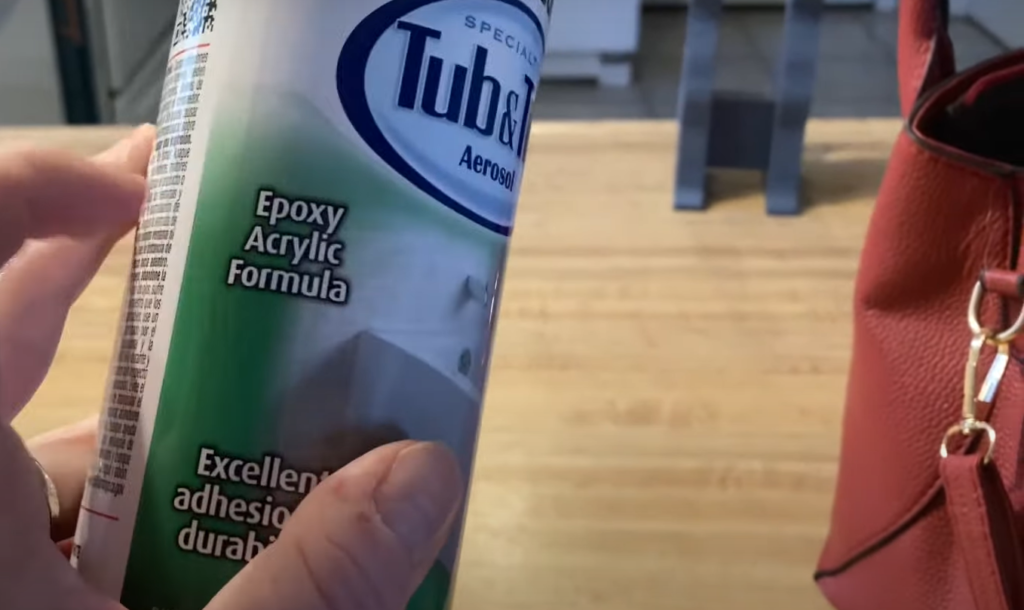
Moreover, acrylic enamel spray paint offers a wide range of benefits. Not only does it provide exceptional resistance to moisture and water ingress and wear, but it also offers excellent adhesion to different materials commonly found in bathtubs, such as porcelain, fiberglass, and ceramic. This versatility allows you to use the paint on various types of bathtubs, ensuring a consistent and professional finish.
Furthermore, acrylic enamel spray paint comes in an extensive palette of colors, allowing you to choose the perfect shade that complements your bathroom’s decor. Whether you prefer a classic white, a soothing pastel, or a bold and vibrant hue, you can find the ideal color to transform your bathtub into a stunning focal point.
This additional layer provides an extra level of protection against daily wear and tear, prolonging the pristine appearance of your bathtub.In summary, acrylic aerosol coating does not only provide durability and a high-gloss finish, but also provides flexibility in material matching and color selection. By choosing this option for bathtub refinishing, you can ensure a long-lasting and visually appealing result that enhances the overall aesthetics of your bathroom.
Epoxy Powder Painting
Epoxy spray paint is an exceptional choice for bathtub refinishing thanks to its excellent longevity, adherence, and resistance to water and everyday wear. This type of paint is a two-part system—that is, it comes in two containers that you mix before application. Once combined, the two parts create a secure, waterproof seal that can withstand high levels of humidity and frequent use, making it ideal for a bathtub’s demanding environment.
Moreover, epoxy paint offers a range of additional benefits that make it an excellent option for bathtub refinishing. It’s hard, glossy finish not only provides an attractive aesthetic but also resists chipping, peeling, and yellowing over time. This means that your refinished bathtub will maintain its beauty and durability for years to come.
Furthermore, epoxy paint adheres well to various surfaces, including ceramic, porcelain, and fiberglass. This versatility allows you to use it for different types of bathtubs, ensuring a consistent and reliable result regardless of the bathtub material.
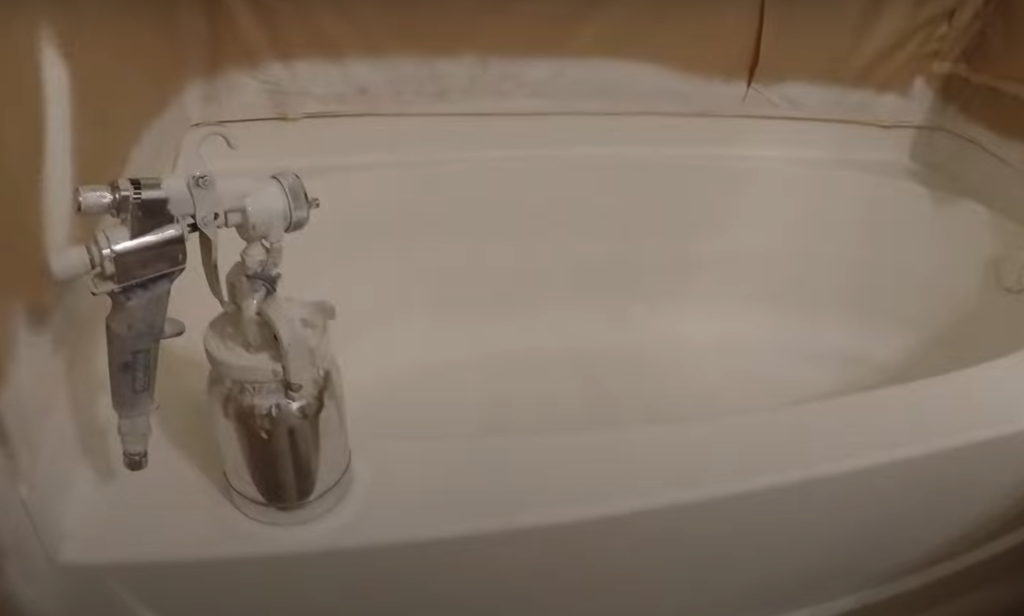
It is important to note, however, that the application process for epoxy paint can be more complex and time-consuming due to the requirement of mixing the two parts in the correct ratio. This meticulous approach ensures optimal performance and longevity of the finish. While it may require a bit of extra effort, the result is well worth it for those seeking a long-lasting, high-quality finish for their bathtub.
In conclusion, with its exceptional durability, resistance to water and wear, as well as its glossy finish and versatility, epoxy spray paint is a worthwhile option for anyone looking to refinish their bathtub. Despite the additional steps involved in the application process, the longevity and overall quality of the finish make it a top choice for those who value a beautiful and long-lasting bathtub.
Urethane spray paint
Urethane spray paint is an exceptional choice for bathtub refinishing, known for its remarkable durability and resistance to water, heat, and sunlight. With its unique formulation, this type of paint forms a strong and flexible coating upon drying, making it highly resistant to cracking or peeling even under stress. Moreover, unlike other paints, urethane paint exhibits excellent color retention over time, maintaining its glossy finish for extended periods.
One of the standout features of urethane paint is its resistance to mold and mildew, which are common bathroom issues due to high humidity levels. By choosing urethane paint, you can safeguard your bathtub against these unsightly and potentially harmful problems. Furthermore, this versatile paint adheres exceptionally well to various surfaces including fiberglass, acrylic, and porcelain, making it a reliable choice for bathtub refinishing projects.
As with any paint, it is important to note that urethane paint typically requires the use of a primer to ensure optimal adherence and durability. Additionally, due to its strong fumes, it is recommended to use protective equipment during application.
Considering its outstanding durability, flexibility, and long-lasting finish, urethane spray paint undoubtedly proves to be an excellent option for bathtub refinishing projects. It not only enhances the overall aesthetic appeal but also ensures a bathtub surface that can withstand the test of time.[2]
How to spray paint your bathtub
Prepare your work area
Before embarking on the bathtub spray painting process, it’s crucial to prepare your workspace thoroughly. Start by removing any bathroom accessories, such as soap dispensers, toothbrush holders, and towel racks, as well as rugs, shower curtains, or any other items that might get in the way or be accidentally damaged by paint overspray.
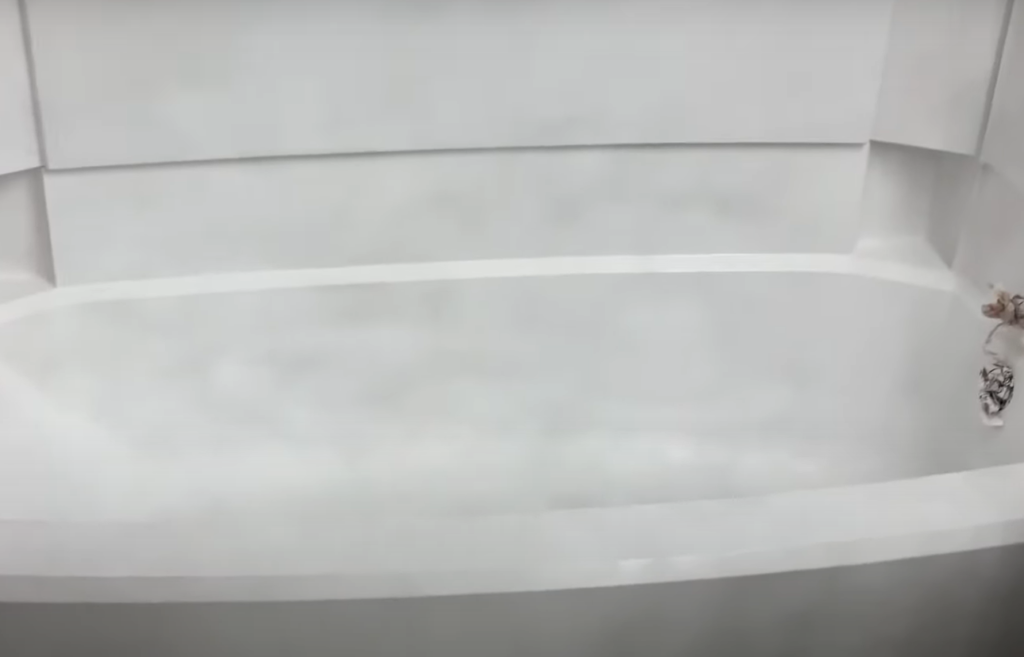
Next, cover the floor around the bathtub with a durable drop cloth or a couple of old bed sheets. This will provide added protection against any potential paint drips or splatters that may occur during the refinishing process. Make sure the cloth or sheets are securely positioned and cover a wide area to ensure complete coverage.
To safeguard nearby fixtures, wall tiles, and the shower area, it’s recommended to tape plastic sheets or painter’s tape over them. This additional step will prevent any accidental paint exposure and help maintain the cleanliness and integrity of these surfaces.
In addition to protecting your surroundings, it’s important to create a well-ventilated work area. To achieve this, consider opening windows or using fans to ensure adequate airflow.
Remember, thorough preparation is the key to a successful refinishing job and to ensure a clean, safe work environment. Taking the time to prepare your workspace properly will contribute to achieving professional-looking results and a satisfying bathtub transformation.
Cleaning and prepping the bathtub surface
Once your work area is prepared, the next step is to thoroughly clean and prep the bathtub surface for painting. Start by using a bathroom cleaner or a mixture of vinegar and water to scrub away any residue, soap scum, or stains. Pay special attention to any areas with hard water deposits or mildew — these need to be spotlessly clean for the paint to adhere properly. Rinse the tub thoroughly and wipe it down with a clean, lint-free cloth.
Once clean, use sandpaper (preferably 400 to 600 grit) to lightly sand the entire surface of the tub. This gentle sanding roughens the surface, allowing the paint to stick better and ensuring a long-lasting finish. After sanding, rinse the tub again to remove any lingering dust particles and let it dry completely. For added precaution, wipe the tub with a tack cloth to ensure no dust or particles remain, leaving a pristine surface ready for painting.
Now, it’s time to tape off any areas that you don’t want to paint, such as the faucet, drain, and any adjacent surfaces. Use painter’s tape and plastic sheeting to protect these areas from accidental paint splatters. Taking this extra step will result in a clean and professional-looking paint job.
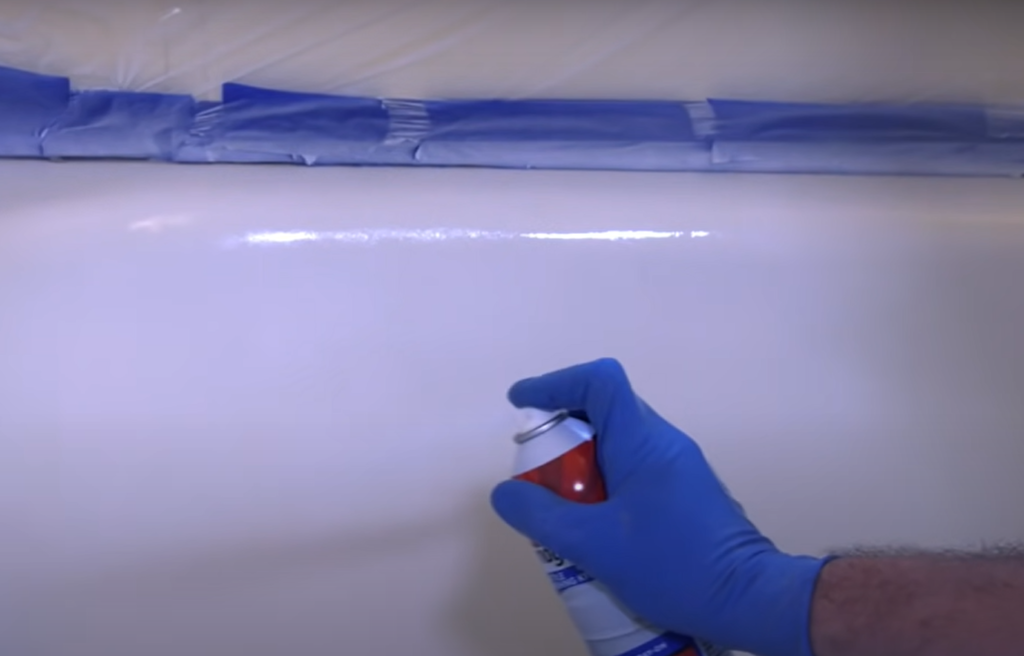
With your bathtub now clean, perfectly prepped, and protected, it’s ready for its new coat of paint. Remember, a thorough and meticulous prep work is the key to achieving a smooth, lasting finish. Invest the time and effort in preparing your bathtub properly, and you’ll be rewarded with a beautifully transformed space that you can enjoy for years to come.
Spray painting the bathtub
To start the painting process, gently shake the can of your chosen spray paint for about a minute to ensure that the paint is thoroughly mixed. Now, while wearing your protective gear, hold the spray approximately 10 to 12 inches away from the surface of the bathtub. Begin spraying by moving the can back and forth in smooth, even strokes, ensuring that the paint is evenly distributed. Remember, the key to achieving a professional-looking finish is to apply multiple thin layers rather than a single thick layer. This technique helps prevent unsightly drips and runs while providing a smoother and more consistent coverage.
After applying each layer, allow it to dry completely before proceeding to the next one. The drying time may vary depending on the brand of paint and the environmental conditions, but typically it takes around 15 to 20 minutes. Take your time and be patient during this process to ensure optimal results.
Make sure to cover the entire surface of the bathtub evenly, paying extra attention to the corners and edges to achieve a seamless finish. The number of coats required will depend on the color and type of paint you are using, but generally, it’s recommended to apply two to four coats for full coverage.
Once you have applied the final coat, it is important to allow the bathtub to dry completely. Ideally, leave it undisturbed for at least 24 to 48 hours to ensure that the paint cures properly and to avoid any smudges or peeling. Patience is key during this stage, as rushing the drying process can compromise the final result.
By following these detailed steps and taking your time, you can achieve a beautifully painted bathtub with a smooth, durable finish that will last for years to come.
Let the paint coat dry
After the final coat of paint has been expertly applied, your job isn’t quite done just yet. To achieve the perfect finish and preserve the pristine look of your newly refinished bathtub, it’s crucial to allow the paint to fully dry. This step requires a good amount of patience and careful attention, as rushing through it could result in unsightly smudges or peeling.
During this critical drying period, it’s important to avoid using the bathtub or exposing it to any moisture. By doing so, you’ll ensure that the paint sets and adheres properly, guaranteeing long-lasting results. Additionally, maintaining a well-ventilated environment in the room will greatly assist in the drying process, facilitating proper air circulation and faster evaporation of excess moisture.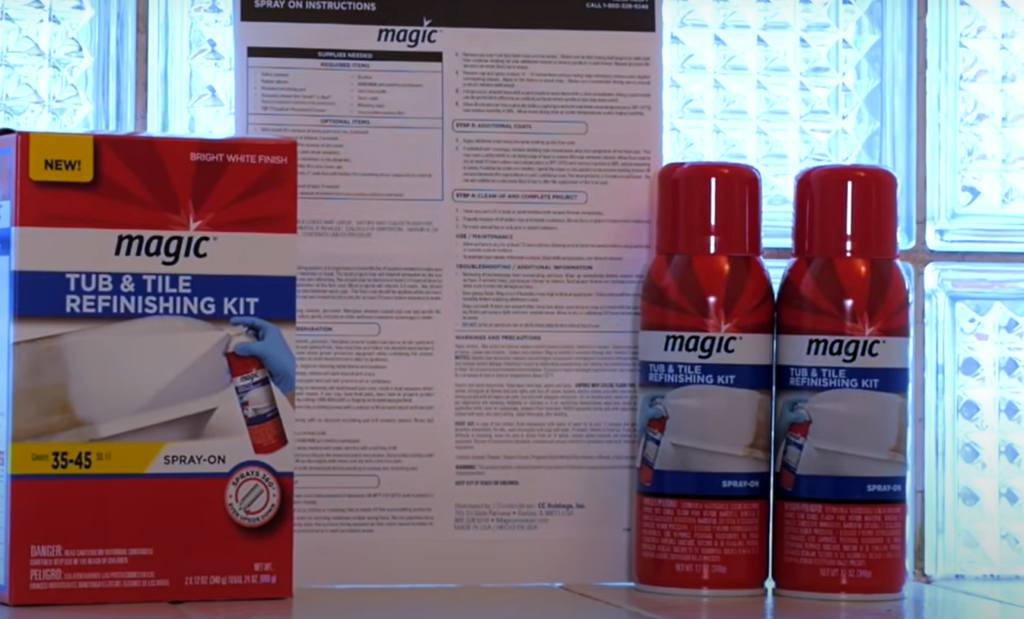
While it may be tempting to touch the tub to check if it’s dry, it’s best to refrain from doing so. Touching the surface prematurely may leave unwanted fingerprints or smudges, compromising the flawless finish you’ve worked so hard to achieve. Instead, exercise patience and give the paint ample time to cure and harden.
Once the paint has fully cured and hardened, you can proceed to remove the masking tape and plastic sheets that were used to protect surrounding areas during the painting process. Carefully peel them away, reveling in the satisfaction of revealing the beautifully transformed bathtub.
Now, with the successful completion of this meticulous spray paint job, you can fully enjoy the refreshed look of your bathtub. Take a moment to appreciate the skill and effort that went into achieving this stunning result. Whether it’s a relaxing soak or an invigorating shower, your newly refinished bathtub is ready to elevate your bathing experience to new heights.
Can you spray paint a plastic bathtub?
Spray painting a plastic bathtub is possible with the right paint and preparation. Epoxy-based paint is recommended for its durability and ability to withstand moisture and wear. The process involves cleaning, surface preparation, masking, applying light layers of paint, and allowing proper drying time. Safety precautions, such as working in a well-ventilated area with protective gear, should always be followed.[1]
What precautions should I take when painting a bathtub?
Safety gear
When spray painting a bathtub, it’s crucial to wear the right safety gear. Safety glasses or goggles shield your eyes from paint splatters. A respirator or mask prevents inhaling harmful paint fumes, especially in poorly ventilated bathrooms. Gloves protect your hands from hard-to-remove paint, while old clothes or a painter’s smock safeguard your attire from stains. Keep a well-stocked first aid kit nearby for any minor accidents.
Choosing the right paint
Choosing the right paint for bathtub refinishing is crucial. Epoxy-based paint is recommended due to its durability and resistance to moisture. It comes in various colors to match your bathroom decor. For plastic tubs, use paint specifically for plastic surfaces. For metal or porcelain tubs, appliance paint works well. Opt for high-quality paint for better coverage and durability. Read the manufacturer’s instructions carefully. Remember to purchase enough paint to cover your tub adequately.
Paint in a ventilated area
When refinishing your bathtub, it’s crucial to paint in a well-ventilated area. Spray paint fumes can be harmful if inhaled excessively, so ensure good airflow. Open windows and use exhaust fans if available. In windowless bathrooms, a portable fan can promote air circulation. Avoid pointing the fan directly at the bathtub to prevent uneven drying.
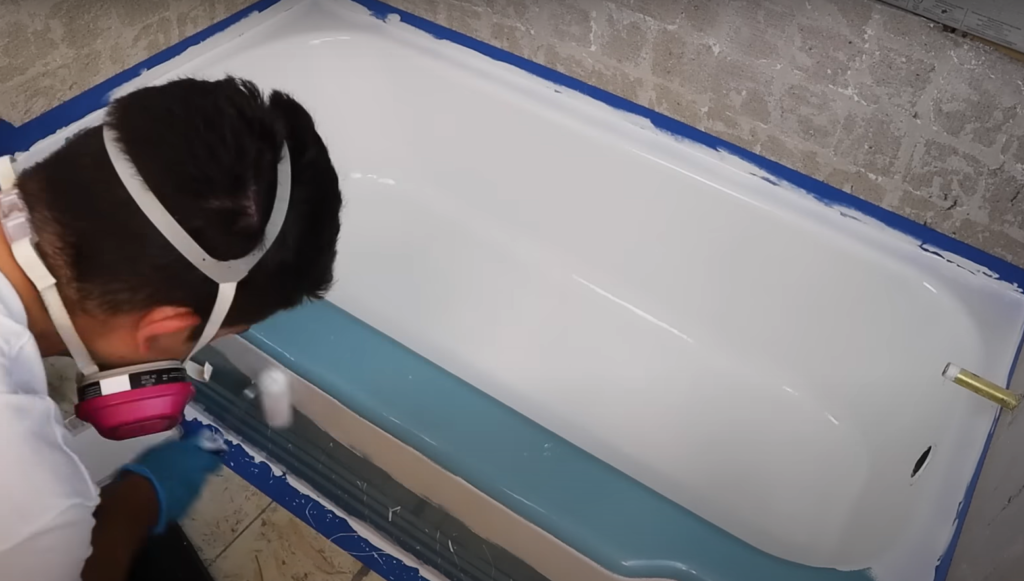
Maintain a consistent room temperature as extreme temperatures affect drying and final result. Remember, safety and health are paramount in any DIY project.[3]
Best paints for painting a bathtub
When it comes to painting a bathtub, there are several reliable options available in the market. These include Rust-Oleum 7860519 Tub and Tile Refinishing 2-Part Kit known for its durability, Krylon K04502007 Tub & Tile Ultra Repair Finish Spray Paint for a convenient application, Homax 720771 32-Ounce Tub and Sink One-Part Spray for easy use, Sheffield Bronze 1126 Porcelain Touch-Up White for porcelain tubs, and ArmaGlaze Original Odorless Bathtub Refinishing Kit for those sensitive to paint fumes. Remember to properly prepare the surface and follow the manufacturer’s instructions for a successful paint job.[3]
FAQ
What kind of paint do you use on a bathtub?
Epoxy-based paint is the most effective and durable option for painting bathtubs. It adheres well to various surfaces like porcelain, ceramic, and fiberglass, making it perfect for bathroom settings. These paints come in different colors and finishes, allowing homeowners to personalize their bathtub’s look. Popular brands include Rust-Oleum Tub and Tile Refinishing Kit and Krylon Tub & Tile Ultra Repair Finish Spray Paint. For plastic bathtubs, use paints specifically designed for plastic surfaces. Always follow the manufacturer’s instructions for best results.
Is painting a bathtub a good idea?
Painting a bathtub can be a cost-effective and transformative option, providing a fresh look without a full remodel. However, proper preparation and high-quality products are crucial for successful results. Thoroughly clean, repair, and prime the surface before applying a durable bathtub paint. While it’s a great way to refresh your bathroom, attention to detail is key for optimal outcomes.
Can you spray paint a ceramic bathtub?
To spray paint a ceramic bathtub, use a paint designed for ceramic surfaces like epoxy paint. Prepare the tub by cleaning it, repairing any damage, and sanding the surface. Apply a primer, followed by the paint and a clear topcoat for protection. Rust-Oleum and Krylon offer suitable products. Ensure proper ventilation during painting. Follow manufacturer instructions for best results.
Can you spray paint an enamel bath?
Spray painting an enamel bath requires a specific process for a long-lasting, high-quality finish. Clean and prepare the surface, sand it for better adhesion, and choose an epoxy paint designed for enamel. Apply thin, even coats, allowing each to dry before adding more. Consider a clear topcoat for extra durability. Proper ventilation and preparation are crucial for the best results.
Can you spray paint a porcelain tub?
Spray painting a porcelain tub can give it a fresh, new look without the cost of replacement. Use the right materials, clean and repair the tub, choose an epoxy-based paint, and apply light, even coats. Allow each coat to dry before adding a clear topcoat for extra protection. Remember good ventilation and follow the manufacturer’s instructions for best results.
How do you spray paint over enamel?
To achieve a durable and smooth finish when spray painting over enamel surfaces, follow these steps: clean the surface, repair any damages, lightly sand for adhesion, apply a suitable primer, use epoxy-based paint in thin coats, and consider a clear topcoat for added protection and shine. Ventilation and following manufacturer’s guidelines are important for safety and best results.
Useful Video: Super simple how to paint a bathtub
Conclusion
Spray painting a bathtub is a cost-effective way to refresh its appearance. Proper preparation, choice of paints and primers, and patient application are key for a long-lasting, high-quality finish. Brands like Rust-Oleum and Krylon offer suitable products for ceramic, enamel, or porcelain surfaces. Ensure proper ventilation and follow manufacturer’s guidelines for optimal results. Transform your bathtub without extensive renovations!
References:
- https://www.marylandtubntile.com/blog/can-you-spray-paint-a-bathtub/
- https://propaintersguide.com/can-you-spray-paint-a-bathtub/
- https://homedecorbliss.com/can-you-spray-paint-a-bathtub/



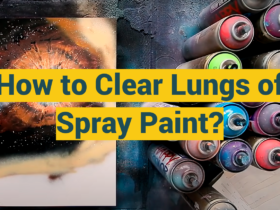

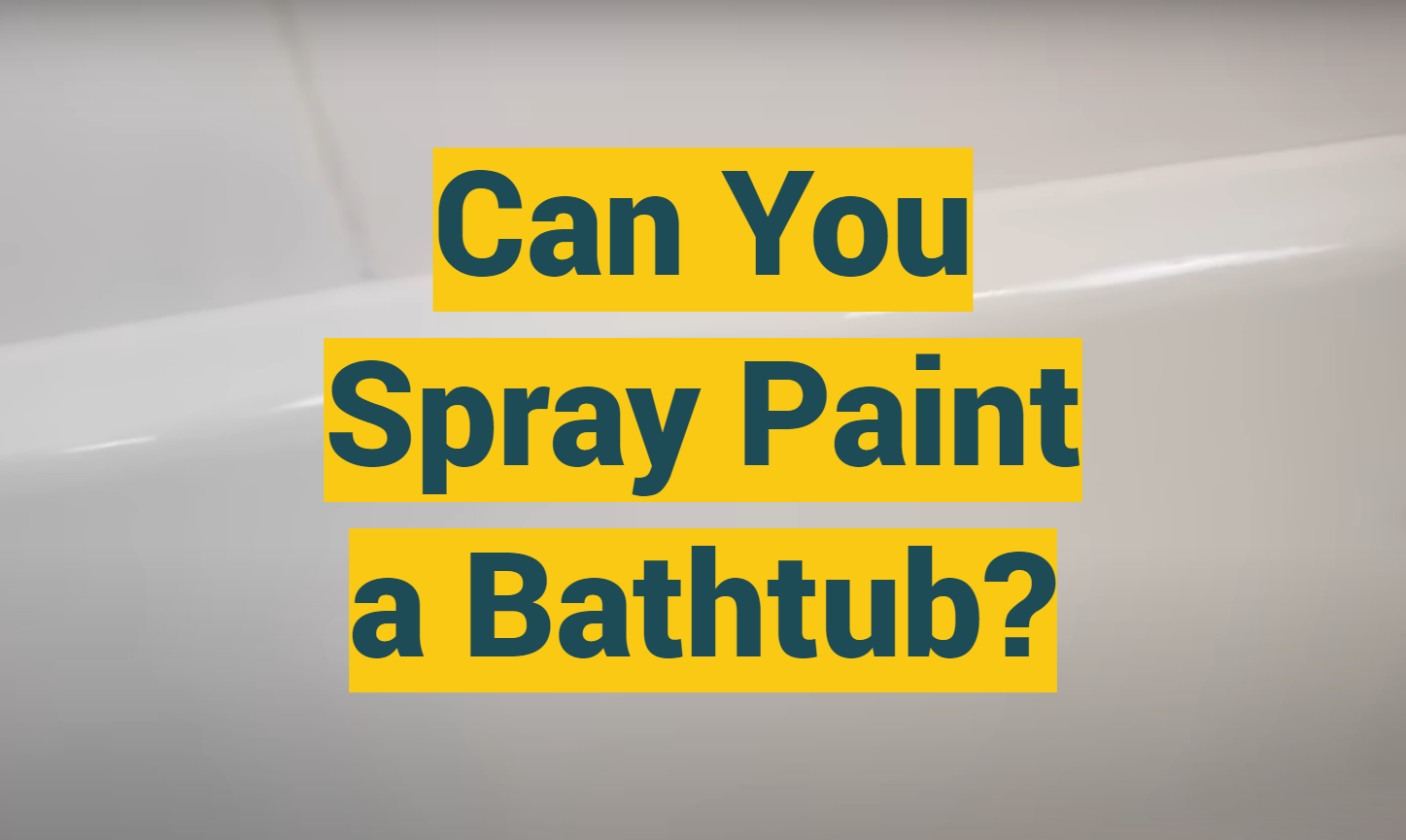




Leave a Review